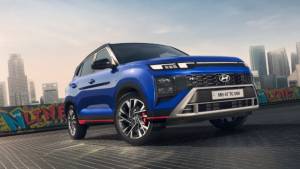Frugal future
Team OD
Updated: May 09, 2013, 04:12 PM IST
In just over two years' time drivers in Europe should be able to buy a diesel-powered Volkswagen that uses less than 1 litre per 100km.
That sounds impossible, as the most frugal VW today, the Polo Blue Motion, achieves 3.5 l/100km and the plug-in version of the Toyota Prius petrol-electric hybrid, arriving in 2012, will have an official consumption figure of 2.6l/100km. But to show that it is serious, Volkswagen allowed us to drive the first XL1 which it unveiled to a bemused audience at a motor show in the energy-rich Gulf state of Qatar.
XL1 is not the usual kind of motor show concept car. It is a fully-functional vehicle equipped and furnished to production car standards. That is because Volkswagen chief executive Martin Winterkorn promised that by 2013 it would be available 'at an affordable price'. That price remains unknown but it is understood that the initial production run will be only a few thousand, and likely to be offered at something over 40,000 Euros.
So it will not be attainable by the hard-pressed family motorist facing escalating fuel prices. XL1 is a statement, a high technology project incorporating materials and technical solutions usually associated with motor racing or the most exotic sports cars. It even looks like a scaled-down supercar, low and aerodynamically- shaped like a baby Lamborghini. Instead of a 320kmph top speed it makes do with 160kmph and the valid claim that it is â" by far - the most efficient combustion-engined production car ever made.
Its carbon dioxide rating â" important for taxation in most European countries - is 24g/km. Only pure electric cars do better as they produce no CO2 (but the method of electricity generation is taken into account, the equivalent figure can be as high as 70g/km). The best of current cars is the Smart ForTwo cdi at 86g/km. The plug-in Prius has a figure of 59g/km, measured by a new European regulation to cover hybrids that run on both electricity and diesel or petrol.
The XL1 is also a plug-in hybrid but it grew from something rather different. In 1999, in response to a challenge from the Green Party in Germany, Ferdinand Piech, the head of VW (and now chairman of its supervisory board) urged his engineers to produce a '3-litre' car.
The resulting Lupo 3L, an expensive version of VW's smallest and cheapest car, didn't sell very well but was the precursor of the special low CO2 models now offered by virtually all manufacturers in Europe. It set Piech thinking about more extreme fuel economy: a 1-litre car. VW built one, a cigar-shaped tandem two-seater with a tiny diesel engine, and Piech proudly drove it from Wolfsburg to Hamburg to his last board meeting as chief executive in April 2002.
In the nine years since, it became clear that a production version, adapted to the requirements and safety of everyday motorists, would be heavier and more elaborate, its performance would be inadequate â" and it would get no more than 2 l/100km.
A re-think was needed. That started with the L1 exhibited at the Frankfurt Motor Show in 2009, which showed that a new economy champion should have a new hybrid power unit, the lightest possible chassis and body panels, and world-beating aerodynamics. Its consumption figure was 1.38 l/100km.
L1 also proved to VW that the tandem layout with an airplane-like canopy was too extreme to be acceptable to most motorists. XL1, the production-ready successor, would have its two seats side-by-side. Furthermore, it would drive like an ordinary car and not require any special techniques to operate.
XL1's hybrid power unit consists of a new two-cylinder 800cc turbo-diesel engine â" effectively, half of the latest four-cylinder 1.6-litre VW TDI but with an aluminium cylinder block â" developing 35kW/48PS, a 20 kW/27PS electric motor and VW's seven-speed automatic DSG (dual-clutch) transmission. Together, the TDI and electric motor deliver a maximum toque of 140Nm. The diesel engine, with exhaust gas recirculation, oxidation catalyst and particulate filter, meets the Euro 6 emissions regulations.
This power unit is mounted transversely behind the seats and drives the rear wheels. A 5kWh lithium-ion battery pack and a 10- litre diesel fuel tank nestle between the engine(s) and the passenger compartment.

Every component has been analysed and designed for the lowest possible weight but the major breakthrough is the carbon-fibre monocoque chassis. The centre, which forms a passenger safety cell, is moulded in one piece by a rapid resin transfer moulding process developed with the Austrian company CarboTech, who use a similar system for the McLaren MP4-12C supercar. It weighs just 65kg and Volkswagen is equipped to make 6,000 a year. The supercar connection doesn't end there. The clean, smooth shape is optimised for aerodynamics and achieves a world record drag coefficient for a production car of 0.186 which combined with a frontal area of just 1.5sq m gives a CdA figure of 0.277, 2.5 times lower than a VW Golf.
XL1 is tapered towards the rear, so the cockpit has the passenger seat a few cm back from the driver's â" to avoid a clash of shoulders â" and it is as low as a Lamborghini, dictating large wing-type doors that hinge upwards and forwards, taking part of the roof with them, for easier ingress/egress.
It feels special â" much like a supercar â" when you are snuggled down into the carbon-fibre driver's seat, confronted by a small steering wheel squared off at bottom and a facia finished to VW's expected high standard. There is no rear window and to avoid interrupting the air flow, side mirrors are replaced by video cameras transmitting to two small screens on the doors.
But there is none of the sound and fury of a Lambo. XL1 is serene as it moves off with electrical power. Everything is remarkably quiet - just the noise of tyres on tarmac - until you press the accelerator harder and demand more power and the diesel engine starts without any jolt but making a curious tinny rattle. Lift the pedal and the gentle calm returns: the engine stops instantly and restarts in milliseconds when you accelerate again.
You can switch it to run only on electricity. In that mode it can run for 35km and up to 80kmph. The batteries take an hour and cost cents to recharge on the domestic mains. For higher speed and longer distances, the electric motor boosts the diesel engine.
The hybrid control unit de-clutches the diesel engine when running in electric mode. It also decides on which gear is to be used at any given time; this DSG operates only as an automatic but a 'low' position can be selected manually to provide optimum energy regeneration when running downhill.
Despite its racy looks, XL1's ultimate performance is leisurely: 0-100kmph in 11.9sec. For all the elaborate and expensive weight-saving measures, it is heavier than one might expect: 795kg, about the same as the Lupo 3L (or a first generation 1975 Golf).
The narrow Michelin low-rolling resistance tyres, which run at 3 bar, contribute to a slightly lumpy ride but the XL1 steers accurately and easily, without the need for power assistance. It has excellent braking from lightweight ceramic discs. Younger drivers may find the pedal feel odd, as it is rare among modern cars in having no brake servo. VW is considering a brake booster when it equips XL1 with ABS and ESP.
Our test drive on the streets of Doha wasn't long enough to check the fuel consumption. You need a good distance â" or very accurate equipment - to verify the official figure, which is actually better than VW expected: 0.9 l/100km.
Conveniently, that figure is also the average that scientists calculate will be required for motor vehicles to meet the EU pledge of restricting global warming to no more than 2deg C by 2050. Other manufacturers present electric and fuel cell cars as the long-term solution. With the XL1, Volkswagen - which will also launch electric cars in 2013 - wants to show that there is another way. One which has a combustion engine but where the use and cost of fuel is almost insignificant.
Related Stories
Top Stories
Latest Videos
Most Popular
1
2
1
2
Network18 Updates
Compare














